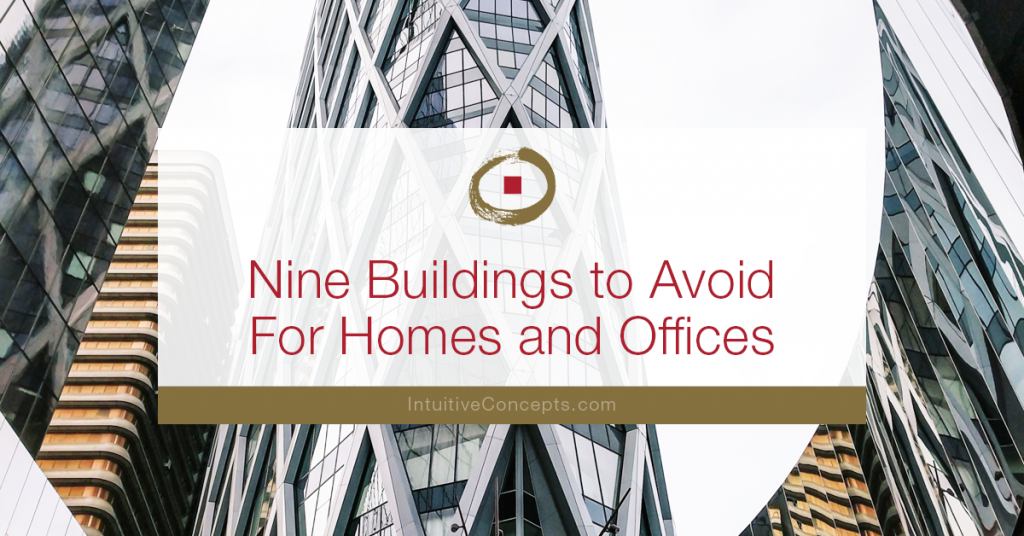
Thus far I have not found a perfect Feng Shui building, especially that I incorporate risk management criteria. If you don’t know what I mean by risk management, visit our article Choose Quality versus Quantity. A building that is 60% workable is the best I’ve encountered in all these years, and 70% would be ideal. The list below explains issues that cannot be easily remedied or physically changed.
There are certainly more things to consider but this list will get you started. I personally would not buy or rent anything on the list but if you have–don’t start packing yet. Allow me to ask, “have you lived or worked there for over a year?” If yes, have you noticed a decline in morale, health, finances, or satisfaction? If no, you’re doing something right and keep it up. If you are having problems, hire an experienced classic Feng Shui consultant. Choose not to be a victim of your circumstances or surroundings. There are solutions so you and those around you struggle less and enjoy more.
Buildings close to a nuclear power plant, power substation, utility-pole transformer, high-tension wires, or airport radar:
We are only starting to realize the impact of EMF (electromagnetic frequency). Those whose cell phones and blue-tooth devices are their primary source of communication should beware. Impacts to brain cells affect our nervous system. The immune system is compromised. Studies are underway, but I digress…
Live or work at least:
- Nuclear power plant – 50 miles away
- Power substation – at least 150 yards away
- Transformer – more than 25 yards
- Airport or Doppler radar – Over a mile away
Structures on or near reclaimed wetlands or garbage-dump sites:
Solid ground equals stability. In addition to risks to the foundation and settling after construction, noxious gases (like radon) are present and undermine health.
Buildings on a cliff edge, ravine or gulch:
These buildings symbolize ‘living on the edge.’ While that sounds attractive to some and can be fun when it is your choice, a constant state of being ‘on edge’ eventually wears us down. If you live or work in one of these buildings, do you feel nervous? Do those around you seem erratic or emotional? Are you anxious about money or relationships eroding? If not, no worries. If you do, there are landscape remedies. I’m often asked, “are you going to tell us we have to move?” Of the hundreds of projects I’ve done, I can count on two hands the number of times clients were asked to move. In all cases, someone in the house had advanced cancer. In all cases, they followed my advice. In all cases, they went on to (and still do) enjoy life.
Structures that have or are near extreme noise or obnoxious smells:
This is called sha (negative) energy, and why I try to educate people that Feng Shui is more than decorating. If you haven’t noticed by now, classic Feng Shui starts with the geography (surroundings). When we say it’s about working with the environment–that means more than the room or house we’re in. In this example, we are working with the senses. When we hear or smell–our bodies react. When it’s too loud or too strong, it can affect our sleep, tranquility, work, and interactions with others. Think of flatulence in a restaurant. Yuk! Does anyone enjoy the sound or smell? Same kind of thing. Even though we can mask noise via headphones or covering it up, those are temporary solutions. We can deal with smells inside but depend on governmental agencies to intercede when they are outside. Regardless, extreme noise or obnoxious smells are not a healthy scenario.
Buildings that are extremely odd-shaped:
Because each direction represents various family members, areas of the body, functions of life, and aspects of business, the ideal situation is for all to be equally represented. This includes the center, so buildings that are U-shaped challenge occupants’ overall balance and stability. In a home, this can be seen as dysfunctional or chaotic. In a business, it can cause planning to be incongruent or piece-mealed. Therefore, square or rectangular buildings are more desirable; but here again, Feng Shui remedies will help.
Structures with a river, ditch, or roadway behind it:
The back of a home or office should represent its yin, or rest, area. That means little activity takes place. This provides stability because yang, or active, areas require more attention. The ultimate goals is a balance of both. The more activity that takes place, the more rest and replenishing is required. Water and traffic are yang activities. When in back, rest is disrupted or “washed away.” This affects health and abundance. Think of how many apartment complexes basically sit on a parking lot. There’s no balance. They usually attract undesirable activities and people.
Homes that have a primary bedroom over a garage:
Vehicles coming and going, gas fumes, people working in the garage … all these disrupt rest, sleep, and health. It’s common practice in metropolitan cities to have tenant floors over an underground garage. Owners are wise to employ Feng Shui, as well as have a floor or two (between the garage and apartments above) be a common area, shops, or restaurant. If the owner hasn’t done this, the occupants need to take matters into their own hands and seek out a Feng Shui professional. Bedrooms that are directly over the garage are best utilized for storage or functions that aren’t performed often.
Structures with a bathroom in the SE or SW:
In classic Feng Shui, the SW area of a building represents the head female, Mother Earth, and is the primary direction for relationships (love, marriage). Knowing what happens in the bathroom, the SW is undermined. Let’s face it, if Momma isn’t happy … no one is happy. SW representing Mother Earth and as an environmental advocate, she needs all the lovin’ she can get! The SE of a building represents the eldest daughter, wind, and abundance. A bathroom here symbolically challenges your wealth, luck, and ability to deal with change. These are risks you can avoid and they can also be addressed.
Structures where death exists; on or very near burial grounds, a building where murder or suicide has taken place:
- Burial grounds – If you saw the movie Poltergeist, that’s Hollywood’s version of what can happen. Believe it or not, extreme cases such as this, although rare, have happened. I have worked with clients where harm (even death) has come to them. Examples of places on burial grounds: A golf course is challenged by weather for its premier event each year; a university has strange things happen.
- Murder or suicide – I’ve been asked to work on some famous houses. Even before I accepted the projects, I explained to the buyers they needed to take the buildings down to the foundation (tear it down) and rebuild. They weren’t willing to do that. I didn’t accept the project. I heard from one of them later they found a practitioner who didn’t require such extreme measures, but in the long run, they had to move. Struck by tragedy, the easier way is rarely the best. In another case, eventually, the (different) buyers tore it down and rebuilt.
Again, while this isn’t a complete list, I hope it helps with your real estate search. Let us hear from you regarding your experiences. If you live or work in one of these buildings, please call us at 1-866-689-6891.
Happy hunting!


Leave A Comment